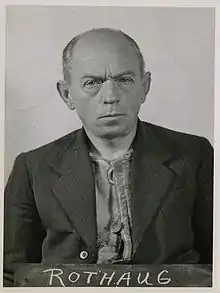
Oswald Rothaug (17 May 1897 – 4 December 1967) was a Nazi jurist.
Life
Rothaug was born in Mittelsinn, Bavaria.[1] In June 1933, Rothaug was named a prosecutor in Nuremberg, and in April 1937, he became the regional court director in Schweinfurt and director of Nazi "special courts" or "Sondergerichte" at Nuremberg. In 1938, he became a member of the German Nazi Party, though he had applied the previous year. He worked closely with the Sicherheitsdienst or intelligence apparatus of the Nazi SS.[2]
In 1942, he sentenced a 25-year-old Polish slave labourer to death, explaining that "the inferiority of the defendant is clear as he is a part of Polish sub-humanity".[3]
Rothaug sought after and presided over the trial of Leo Katzenberger in March 1942, ordering his execution for "racial defilement" in May 1943.[4] Rothaug accused the elderly Jewish man of having sexual relations with a younger German woman, Irene Seiler, which was a crime in Nazi Germany according to the Rassenschande or "racial purity" laws, a part of the Nuremberg Laws. Both Katzenberger and Seiler denied the accusations. Following the trial, Rothaug was brought to Berlin as a member of the Nazi People's Court.
During the Judges' Trial at Nuremberg, Rothaug was sentenced to life imprisonment on 14 December 1947 for crimes against humanity. He was the only defendant to be convicted of crimes against humanity, but acquitted of war crimes. Nonetheless, the court commented in its judgment that:
By his manner and methods he made his court an instrumentality of terror and won the fear and hatred of the population. From the evidence of his closest associates as well as his victims, we find that Oswald Rothaug represented in Germany the personification of the secret Nazi intrigue and cruelty. He was and is a sadistic and evil man. Under any civilized judicial system he could have been impeached and removed from office or convicted of malfeasance in office on account of the scheming malevolence with which he administered injustice.[5]
His sentence was later reduced to 20 years, and he was released on parole on 22 December 1956.[6]
Death
Cultural references
Rothaug's role in the Katzenberger trial was inspiration for the plot surrounding the fictional characters Ernst Janning and Irene Hoffman Wallner in the 1961 film Judgment at Nuremberg.
References
- 1 2 Schäfer, Rechtsanwalt Professor Bernhard Armin (2021). Denkschrift über Dr. Robert Kempner anlässlich 1700 Jahre jüdischen Lebens in Deutschland, anlässlich des 150. Geburtstages von Frau Prof. Lydia Rabinowitsch-Kempner sowie des 75. Jahrestages des Endes des Nürnberger Prozesses gegen die Hauptkriegsverbrecher. Rechtsanwalt Bernhard Armin Schäfer. Hamburg. ISBN 978-3-347-29540-7. OCLC 1259349083.
{{cite book}}: CS1 maint: location missing publisher (link) - ↑ Ernst Klee: Das Personenlexikon zum Dritten Reich. Wer war was vor und nach 1945. Fischer Taschenbuch Verlag, Zweite aktualisierte Auflage, Frankfurt am Main 2005, ISBN 978-3-596-16048-8, S. 510.
- ↑ Zitat bei Ernst Klee: Das Personenlexikon zum Dritten Reich, Fischer Taschenbuch 2005, S. 510.
- ↑ Kohl, Christianne, "The Maiden and the Jew" pp. 140–148, Hoffman und Campe, Hamburg, 1997.
- ↑ Linder, Douglas O. "Nuremberg War Trials: The Ministries Cases (The Nazi Judges Cases)". University of Missouri–Kansas City School of Law.
- ↑ The Holocaust : an encyclopedia and document collection. Paul R. Bartrop, Michael Dickerman. Santa Barbara, California. 2017. ISBN 978-1-4408-4084-5. OCLC 967457463.
{{cite book}}: CS1 maint: location missing publisher (link) CS1 maint: others (link)
Bibliography
- Ernst Klee: Das Personenlexikon zum Dritten Reich. Wer war was vor und nach 1945? S. Fischer, Frankfurt am Main 2003, ISBN 3-10-039309-0.
- Kohl, Christianne, "The Maiden and the Jew", Hoffman und Campe, Hamburg, 1997.